I tend to underestimate brown. When considering colors for an embroidery project, it’s never one of the first colors I think of.
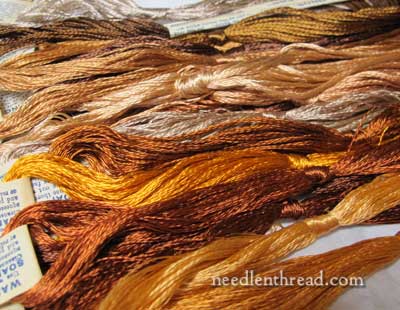
But embroidery thread manufacturers know – and have known for a long time – that brown is one of those essential colors, and so essential, in fact, that browns – all manner of browns – often make up a decent chunk of the colors available in a line of embroidery thread.
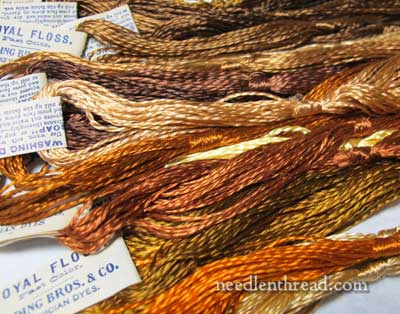
There are brown-browns. There are green-browns. There are gold-browns and yellow-browns. Tannish-browns and blackish-browns. Reddish-browns. Grey-ish browns. Pinky-browns. Taupey-browns. There are white-ish browns, even.
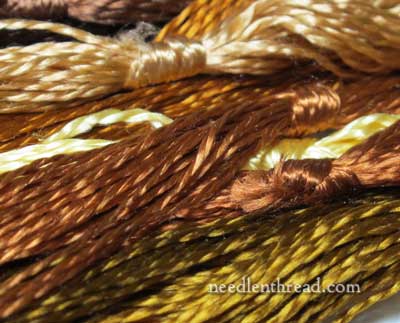
And browns can be used for much more than just tree trunks and twigs, hair and beards, birds and beasts. They can be blended into other colors to produce subtle shading – or to trick the eye into seeing a whole different color.
Browns are definitely a key player in skin tones, especially if you don’t want your embroidered faces and hands to look dead and flat.
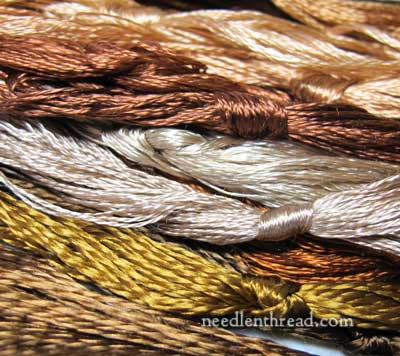
They mix with greens, with reds, with blues, with golds beautifully, to shade or accent.
Lighter browns can be mixed with shades of white to give white elements dimension. (For example, I used shades of light browns frequently with the whites in this Agnus Dei project.)
This is stuff I know about brown. And yet, when I approach planning colors for a needlework project, the browns come as an afterthought.
I underestimate brown. But I’m working on that. I’m trying to Think Brown more often when planning my needlework.
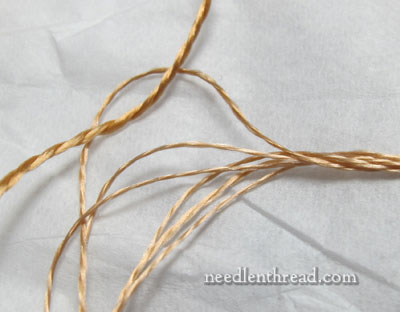
The threads in the photos above are antique silks produced somewhere between the end of the 1800’s through the beginning of the 1900’s by Belding Brothers, which I’ve written about before. There are two types of silk in the photos – one is called “Royal Floss,” a heavier, single strand of lightly twisted silk (you can see it at the upper left on the photo directly above), and the other is “Filo,” a stranded silk floss that separates into six fine strands.
The silks produced by Belding Brothers and other silk mills in the US & Canada figured heavily in the Society Silk era in American embroidery history, and they were also the key element in most ecclesiastical embroidery produced in this country from the mid-1800’s through the mid-1900’s.
They had a lot of browns available. They didn’t underestimate brown.







I’m a terrible underestimator of brown too. I’m working on a peacock tail at the moment and was quite shocked to realise, when actually observing (rather than just looking at!) a peacock tail, how much brown there is in there!
To me all those brown look beautiful. The color of the earth, nature and more.
Dear Mary
Wow! your photos show such a beautiful range of browns, yes I underestimate browns as well not one I would consider first as the prime colours I like to use are reds, greens, yellows and white but after this post I will consider brown as there is so much variety and brown mixes well with other colours as via your photos. Love the antique silk brown threads.
Regards Anita Simmance
To me all those browns look beautiful. The color of the earth, nature and more. I would love to have all those threads.
Thank you very much for this informative post. I have surely learned some great things. The brown floss was always under estimated by me.
Mary, I love this post! You are right. Brown is one of the most intriguing and complex colors in an embroiderer’s palette. I like to think of brown in terms of shadows of other colors such as red, green, yellow or blue. For example, if one were stitching a red rose petal in the shade, it does not always require a darker red when a brown with red tones would be a better choice. I find too, that brown in an embroidery design settles things down. It provides a subtle, yet earthy contrast by adding a dimension to a design element that otherwise would be less visually interesting no matter what the stitch is. Look at nature and see how much brown infuses what we see!
I loved the colors you showed. I have the opposite problem. I LOVE browns and have almost more brown than greens since I lean towards many landscapes. I figure you can never have too many of browns or greens.
Bette
Hi Mary,
I agree, brown can be beautiful. I didn’t realize it until I saw a dress that was the most beautiful shade of brown that was not dark but not light either. I love using brown in embroidery.
Good luck with your project.
ji
Hi Mary,
Just a question, do you actually use those antique silks to embroider?
I have old silk threads that I´m trying to use up because when I use them they start to disintegrate. Does that happen to you?
Thanks,
Candice
Hi, Candice – yes, they can be used. I prefer to keep them for repairing old vestments and whatnot, but some day, I might stitch a small project with some of the odds and ends of this silk that I have on hand. We’ll see! I’m a little hesitant to do a full-fledged project here on Needle ‘n Thread that uses threads that are no longer made, or that would be difficult to find a substitute for, just because if people want to follow along and stitch it, it would be a pain to come up with the exact substitutes. But some day, I may do a little project, just for the fun of it. ~MC
I agree – browns have a lot of mileage and some ranges are hopelessly deficient when it comes to variety. I’m thinking of Anchor #12 pearl cottons, both in the old and new colour ranges, and Derwent Pastel Pencils – at least in the old range. I know the latter isn’t thread, but it’s still a colour range and I used to struggle to get the right browns.
Brown has more life than black.
Brown is one of my very favorite colors! Especially warm browns– like horse chestnuts. Yo up browns are gorgeous.
G’day Mary,
Brown, just the name sounds so…brown, but green-browns, gold-browns, tannish-browns, red-browns, grey-browns…now that’s different!
Cheers, Kath.
Brown must have the same publicity agent as gray. So many people think “blah” at those 2 colors, but they don’t realize how many colors there really are. Come to think if it, white has a huge number of colors too. At least in paint chips if not threads.
If I’m not mistaken, brown, gray and white don’t have a designated section on a color wheel? I mean like blue or red do. They’re all mixes of the other colors?
I feel the same way about stitching with browns, they are always my last pick. I’m attracted to the bright pretty colors. Funny though, I do wear a lot of brown clothes! I loved reading about the antique silks. I just found a large bag of mixed silk and fake silk bundles at a local thrift store. I loved the vintage tags. I have some Potter’s “Braided” Art Floss. The thread is contained in a long paper sheath. It’s 9 1/2″ long and has a ton of printing on it. Have you ever seen these before?